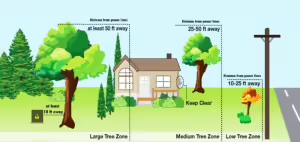Right-of-Way Clearing
Wake Electric maintains nearly 1,900 miles of overhead lines. Routine maintenance helps reduce the risk of outages and ensures reliable service to our members. Storms, high winds, or lightning can send branches into power lines, causing outages and creating safety hazards. Trained contractors perform our right-of-way maintenance. Please do not approach them for safety reasons. If you have concerns, call us at 919.863.6300 or 800.474.6300.
Our Right-of-Way Program Includes:
- Tree Pruning: Regular pruning prevents interference with power lines.
- Hazard Tree Removal: Dead or hazardous trees are removed to prevent risks.
- Mowing and Brush Clearing: Clearing small trees and brush along our lines to maintain access for service vehicles.
- Herbicide Application: Herbicides are used to prevent the regrowth of woody vegetation. Spraying occurs June through September, ensuring lasting results over time.

